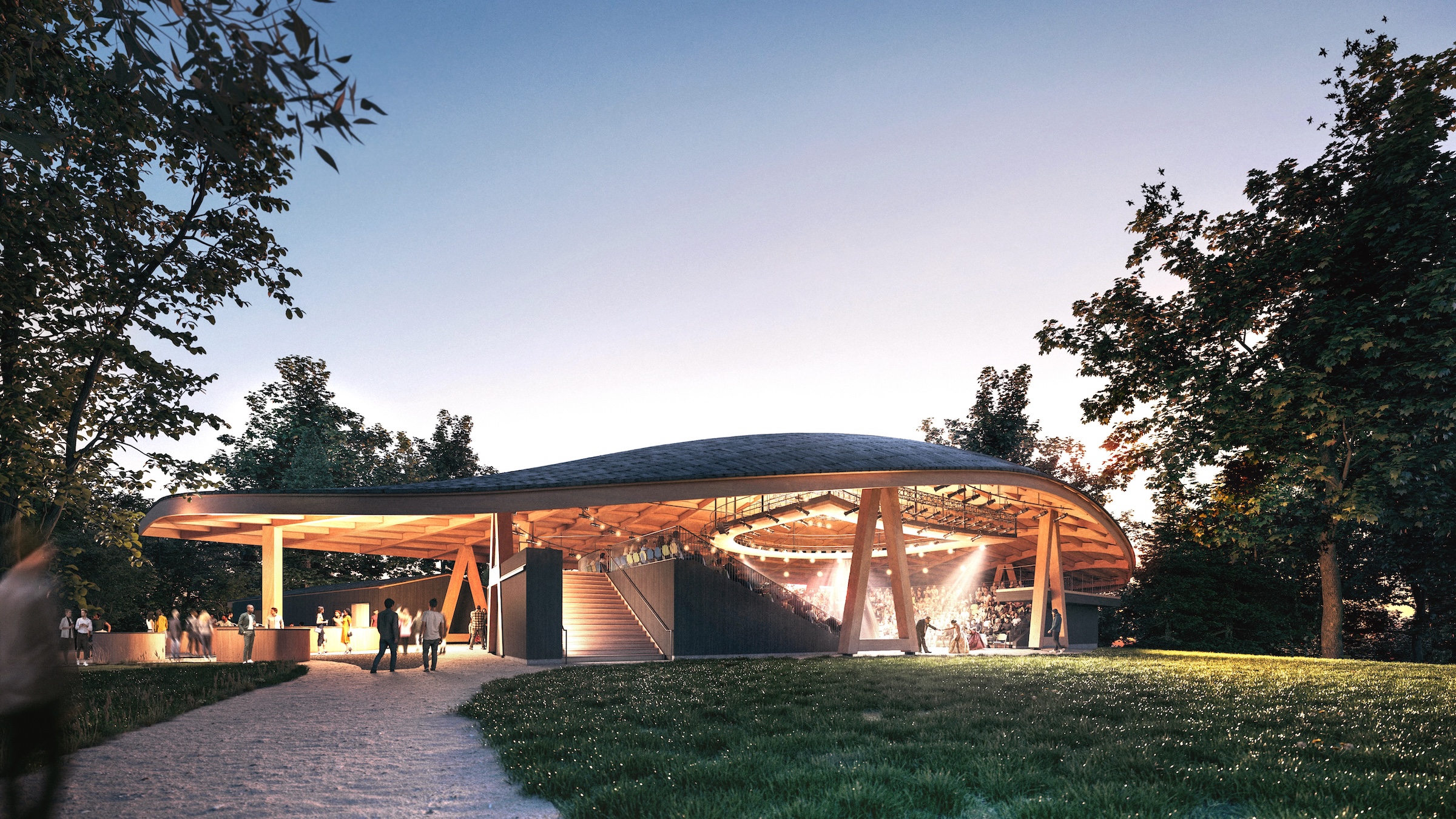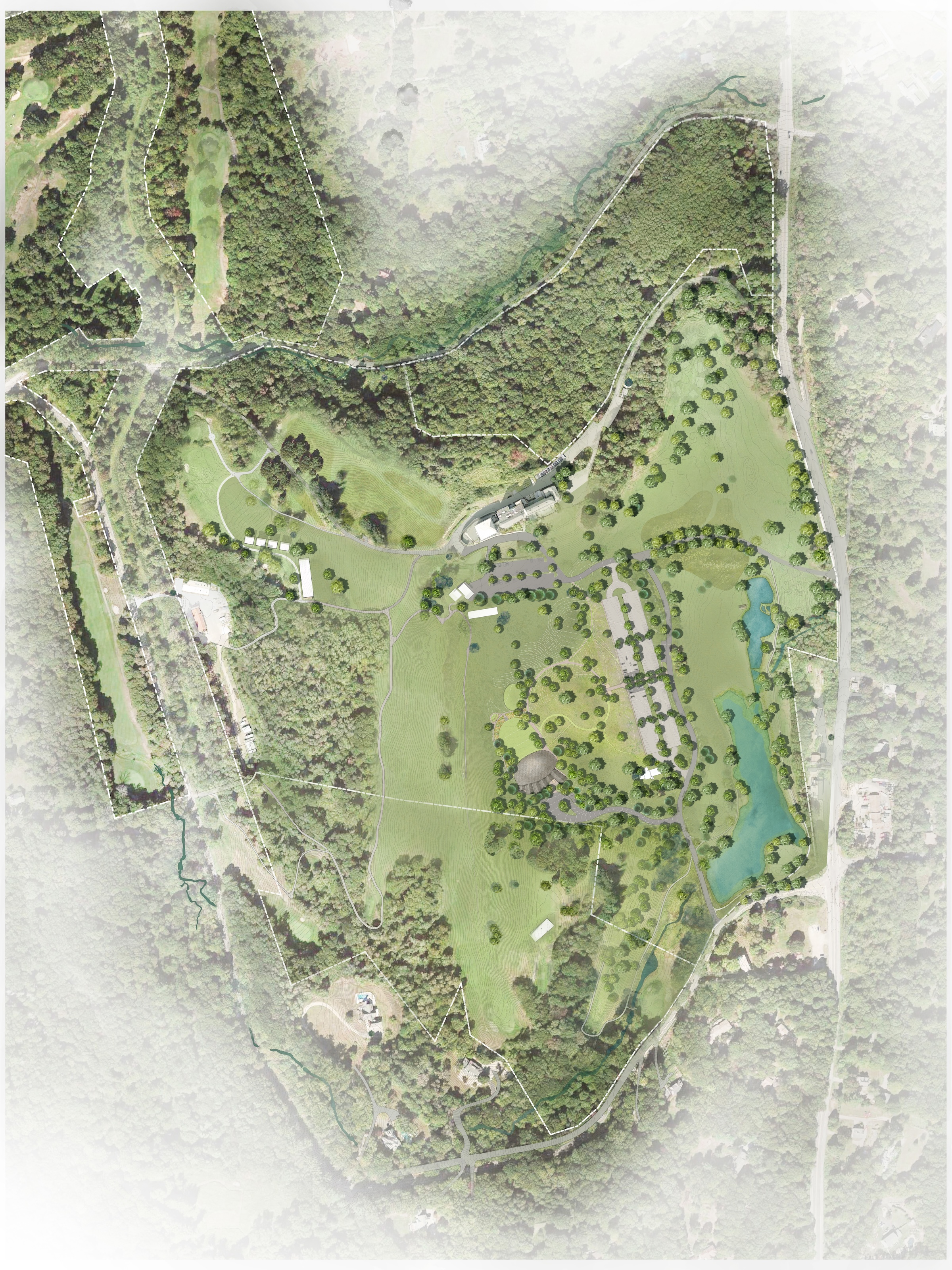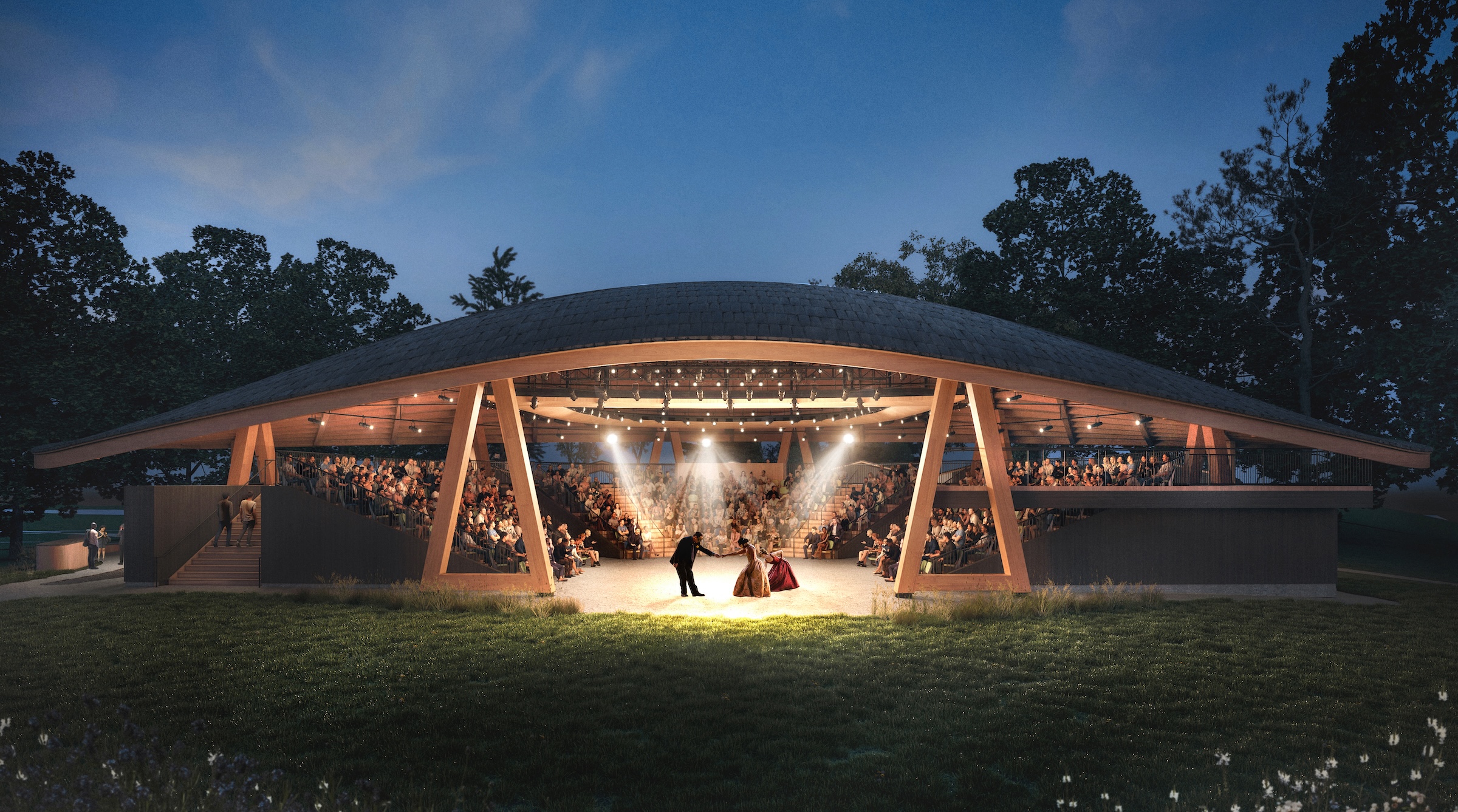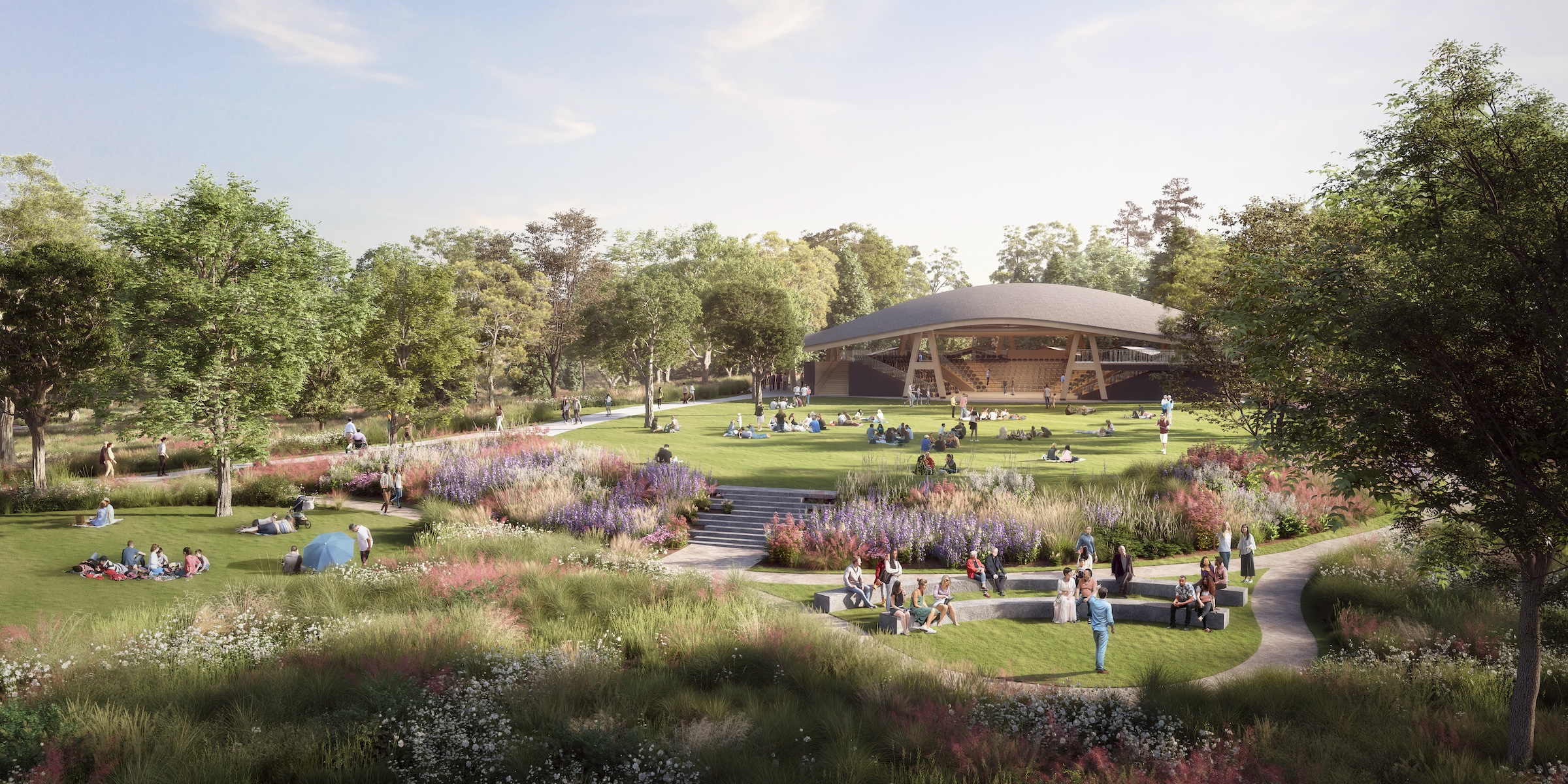A new permanent home for Hudson Valley Shakespeare, a professional non-profit theater company, recently broke ground in Garrison, N.Y. The Samuel H. Scripps Theater Center includes a 14,850 sf performance venue that will serve as a permanent home for the theater company known for its sweeping open-air productions of classics and new works. The theater, located 80 minutes north of Manhattan, is set against the backdrop of the Hudson River and the surrounding landscape of a 98-acre campus.
The structure will be the first public purpose-built LEED Platinum theater in the United States and is the centerpiece of a design with extensive green space and rewilding across the campus, a former golf course. Designed by Studio Gang, the facility will be a singular theatrical destination for New York and the wider performing arts community and a cultural anchor for Hudson Valley, while providing the company with greater versatility for actors, audiences, and back-of-house operations. It will extend the viable performance season into the fall.
The theater’s curved, timber-framed grid shell and timber columns emerge from the landscape to create a dialogue with the Hudson Highlands. The stage’s proscenium arch is oriented to frame picturesque views of the Wey-Gat (Dutch for “Wind Gate”) of Storm King Mountain, the Hudson River, and Breakneck Ridge, and allows actors to use the existing topography to emerge from the landscape. Anchored by an open-air theater, the program is spread across several pavilions that include a back-of-house facility, a concession building, and public restrooms.
Each pavilion is clad in natural materials evoking the minerality of the region. Outdoor gathering spaces adjacent to the theater encourage visitors to connect with each other in an extraordinary natural setting, while a nearby overlook offers an intimate space for pre- and post-performance programming.
The landscape design rehabilitates the former golf course to restore native grasses and wetlands supporting biodiversity and decreased resource use. Nearly 14 acres of new plantings will include 250 native or adaptive trees, native grasses, forbs, and perennials, and bioretention areas that collect and filter stormwater runoff. The landscape is designed as an experiential sequence. Upon arrival to a gravel parking area, visitors encounter a mix of unpaved and accessible paths that guide them up and through native meadows, immersing them in nature and providing views out to the Wind Gate, and ultimately leading to the hilltop theater and gathering areas.
Much of the site was left open for future walking trails or other community uses, while 25,000 sf of picnic lawns, shaded by new native trees, offer an abundance of vantage points to take in the view and enjoy pre-show programming. The design employs several features to enhance environmental performance, including natural ventilation and brise soleil systems, low embodied carbon structure and cladding, and rooftop solar panels.
Project Team
Owner and/or developer: Hudson Valley Shakespeare
Design architect: Studio Gang
Architect of record: Studio Gang
MEP engineer: Buro Happold
Structural engineer: Thornton Tomasetti
General contractor/construction manager: Consigli Construction





Related Stories
| Oct 12, 2014
AIA 2030 commitment: Five years on, are we any closer to net-zero?
This year marks the fifth anniversary of the American Institute of Architects’ effort to have architecture firms voluntarily pledge net-zero energy design for all their buildings by 2030.
| Oct 2, 2014
Budget busters: Report details 24 of the world's most obscenely over-budget construction projects
Montreal's Olympic Stadium and the Sydney Opera House are among the landmark projects to bust their budgets, according to a new interactive graph by Podio.
| Sep 24, 2014
Architecture billings see continued strength, led by institutional sector
On the heels of recording its strongest pace of growth since 2007, there continues to be an increasing level of demand for design services signaled in the latest Architecture Billings Index.
| Sep 22, 2014
4 keys to effective post-occupancy evaluations
Perkins+Will's Janice Barnes covers the four steps that designers should take to create POEs that provide design direction and measure design effectiveness.
| Sep 22, 2014
Sound selections: 12 great choices for ceilings and acoustical walls
From metal mesh panels to concealed-suspension ceilings, here's our roundup of the latest acoustical ceiling and wall products.
| Sep 9, 2014
Using Facebook to transform workplace design
As part of our ongoing studies of how building design influences human behavior in today’s social media-driven world, HOK’s workplace strategists had an idea: Leverage the power of social media to collect data about how people feel about their workplaces and the type of spaces they need to succeed.
| Sep 3, 2014
New designation launched to streamline LEED review process
The LEED Proven Provider designation is designed to minimize the need for additional work during the project review process.
| Sep 2, 2014
Ranked: Top green building sector AEC firms [2014 Giants 300 Report]
AECOM, Gensler, and Turner top BD+C's rankings of the nation's largest green design and construction firms.
| Aug 25, 2014
Ranked: Top cultural facility sector AEC firms [2014 Giants 300 Report]
Arup, Gensler, and Turner head BD+C's rankings of design and construction firms with the most revenue from cultural facility projects, as reported in the 2014 Giants 300 Report.
| Jul 28, 2014
Reconstruction market benefits from improving economy, new technology [2014 Giants 300 Report]
Following years of fairly lackluster demand for commercial property remodeling, reconstruction revenue is improving, according to the 2014 Giants 300 report.
















